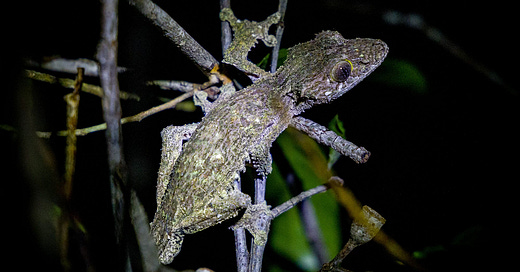Beyond the Lemurs: Madagascar’s Unique Wildlife
A deep dive into the island’s biodiversity, from chameleons to baobabs, and why conservation matters
When I first set foot in Madagascar, I knew it would be extraordinary - but nothing quite prepared me for the sheer otherness of it all.
Yes, lemurs are incredible (and who doesn’t love a lemur with big, curious eyes?). But the real magic lies in what most people never hear about: the iridescent flash of a panther chameleon disappearing into the undergrowth, the towering presence of baobabs standing silent in the twilight, and the tiny frogs that make music in the rainy season.
Madagascar isn’t just a place - it’s a world unto itself. And it’s a world that desperately needs our attention.
An Island Shaped by Isolation
Madagascar has been cut off from mainland Africa for over 80 million years, which in evolutionary terms is… well, massive. This isolation has led to a kind of biological explosion - around 90% of the island’s species are found nowhere else. Think about that for a moment: every time you walk through one of Madagascar’s forests, you’re stepping into a story that exists nowhere else on Earth.
Chameleons That Could Be From Another Planet
Madagascar is home to half the world’s chameleon species - some no bigger than your thumbnail, others bright enough to rival a paintbox. Their eyes rotate independently (something I still find eerie and brilliant), and their tongues shoot out with ridiculous accuracy. I still remember the first time I spotted a leaf-tailed gecko camouflaged so perfectly on a tree trunk I would’ve walked right past it if Tsiraiky hadn’t pointed it out. It’s like the island doesn’t want to be easily seen - it rewards those who take time to look closely.
Baobabs: Timekeepers of the Landscape
And then there are the baobabs. These giants of the plant world feel ancient because they are. Some are thought to be over a thousand years old, quietly storing water in their swollen trunks, watching generations come and go. Standing beneath them, especially at sunset on the Avenue of the Baobabs, you get that rare feeling of being small in a way that’s comforting - like nature’s got a longer memory than we do.
What’s at Risk
But let’s be honest. Madagascar’s biodiversity is in trouble.
Deforestation, climate change, unsustainable farming practices - these are more than headlines here. They’re daily realities. Forests that once teemed with life are shrinking fast. Entire species are disappearing before they’ve even been given names.
And that raises a bigger question I often sit with: Should everything be discovered? Should everything be named?
In a Western scientific sense, naming gives something value, makes it “real” or “worth saving.” But here, so much of the knowledge is held within communities - passed down through stories, through use, through a deep understanding of how things fit together. Not everything has to fit into a catalogue to be worth protecting.
Still, from a conservation standpoint, when a species isn’t officially recorded, it often slips through the cracks - unseen, unprotected, and vulnerable. We’ve already lost things we never even knew existed. That quiet tragedy plays out again and again.
And communities that have relied on these ecosystems for generations are being left with fewer options, fewer resources, and uncertain futures. I’ve worked in conservation for over a decade, and I’ve seen how fragile the balance is - how quickly things unravel when nature is treated as expendable, and when the people who know it best are excluded from the conversation.
Conservation That Centres People
This is why we created Miremby - not just to show people Madagascar, but to connect them with it. Real conservation, the kind that lasts, only works when it includes the people who live alongside the wildlife. That means listening to communities, working together, and ensuring tourism benefits everyone, not just outsiders.
When you support conservation here - whether by travelling ethically, donating, or simply learning more - you’re part of something much bigger. You’re helping preserve not just species, but stories. Ways of life. Ancient knowledge. A future where people and nature thrive together.
So, Why Does It Matter?
Because Madagascar is irreplaceable.
Because every chameleon, baobab, and lemur tells a story of resilience and beauty.
Because the world would be far less magical without them.
And because we still have time to protect it - but only if we act now.
If you’d like to see this biodiversity with your own eyes and meet the people working to protect it every day, we’d love to welcome you to Madagascar. At Miremby, we offer immersive, respectful journeys that support local communities and conservation efforts on the ground.
Together, we can move beyond the lemurs - and into the wild, beating heart of Madagascar. 🌿
Thanks for reading. If this post resonated with you, feel free to share it. And if you’d like to see this biodiversity in person, meet the communities working to protect it, or learn more about how we do things at Miremby - our inbox is always open.
📞Whatsapp: + 44 7457 402703







Well said Bethany.